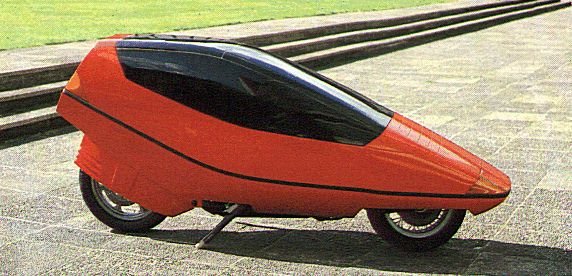John Ewans GPZ 1100 FF
John built this machine in the early 1980s as a design study while he was a postgraduate student at the Royal College of Art. It's not just a mock-up - all the parts are there for it to be driven. For many years it was 'parked' forlornly in a corridor in the Imperial College Mechanical Engineering building but in the early 'noughties' it was given a richly deserved home at the Sammy Miller Museum on the edge of the New Forest at New Milton, in Hampshire. The underlying chassis has been run off-road and it uses a Difazio centre hub front and a Kawasaki GPZ1100 engine. It was designed to use hydraulically powered "skids" to hold the bike up while stationary and these are fully operational. It is one of the most elegant designs ever created in glass and metal but would need a lot of work and pieces added before it could be used on the road. In particular, the shape of the windscreen would probably have to be made of plastic due to its shape which would then create problems with scratching from wipers although there are now some materials that might deal with this (as used by the Ecomobile and Monotracer, for example). In its basic form, the design showed an exceptionally low drag coefficient of 0.25 suggesting a potential top speed of over 180 mph. Pretty damn good for 1983. I sent this photo to Motorcycle News to illustrate the points I made in a letter to them about Honda's massively overstated claims that the then-new SuperBlackbird was the most aerodynamic motorcycle ever made. To their credit, MCN printed it alongside my letter. PNB



Even though the design is now
Even though the design is now over a quarter of a century old, it's still striking, and it would be interesting to see a slightly updated version which adressed it's practical shortcomings. Could a superscoot chassisbe chopped to create a mid/rear-engined version? Would an electric variant, taking advantage of lighter materials and the highly aerodynamic shape, be a possibility? One suspects that the landing gear would remain a major hurdle to overcome, although a hydraulically-driven variation on Ross Cowie's invention might be a neat solution. Alex Lowe